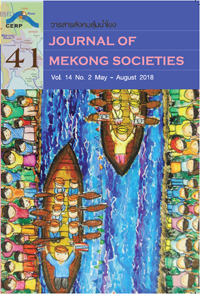Water Resource Management Practices at the Community Level and Structural Changes in Water Resource Management
Main Article Content
Abstract
This article is based on a study of water resource management practices at the community level and structural changes in water resource management. The study employed qualitative research methodology and applied the structuration theory for analysis. The results indicated that the selected village community of Baan Ruamjai (alias) had faced droughts almost every year, which affected the agricultural production and livelihood of its inhabitants. Under such stressful conditions, villagers were able to successfully solve some of their water problems collectively. The community’s water management practices were reproduced based on local wisdom in water management that had been cultivated through time. These experiences enabled the groups and the community to critically reflect upon the government’s larger water resource development project in the locality. Reflexive monitoring was made possible by the practical consciousness or the tacit knowledge of water and forest management and discursive consciousness or critical reasoning. These practices led to the community’s initiation of practices in water resource management that differed in some ways from what the state was doing. This research thus argues that the community’s practices have created two structural changes in the water resource management system at the local level, namely 1) the structuration of an integrated water resource management system which integrates co-management of water and forests, and 2) the structuration of a collaborative water resource management system which integrates several key sectors in the management process. Such structural changes have enabled the village community to have better access to and control over resources in water management, as well as better and broader transfer of their knowledge and practices in water resource management.


